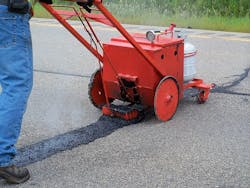Private enterprise finds a more effective way to handle snow and ice on 121-mile Canadian highway
MRDC Operations Corp. (MRDC), a private enterprise responsible for maintaining and rehabilitating a 121-mile highway connecting the cities of Fredericton and Moncton in New Brunswick, Canada, began manufacturing and using salt brine several years ago for pre-wetting road salt during deicing operations and for anti-icing operations.
Previously, MRDC manufactured salt brine using conventional brine systems installed at three major depots along the highway. Recently, MRDC implemented a program encompassing new equipment installed at one central location and holding tanks installed at each depot.
“We recognized the importance of salt brine production in relation to its usage and potential,” said Mark Kenny, professional engineer and MRDC operations manager. “We further realized that improvements or replacements to the former brine production system were necessary to attain the levels of service and efficiencies desired for providing winter-maintenance services.”
During earlier years, MRDC made salt brine on the fly during spreading operations, since the facility did not have any holding tank capacity at that time. That amounted to manufacturing about 1,056,000 gallons of salt brine each year.
“Because of our limited quality-control measures for checking salt concentrations at that time, we limited our anti-icing window to pavement temperatures of 23 °F and above,” said Kenny. “A hydrometer was used by the operators to measure the salt concentration in the brine prior to loading, and making brine on the fly was not deemed effective or efficient in terms of operating cost and levels of service with respect to plowing cycle times.”
With the help of other North American agencies, and the sharing of information between colleagues at American Public Works Association shows, MRDC acknowledged their need to optimize their liquid operations in terms of production, quality control, transportation and storage to effectively and efficiently deliver winter-maintenance services.
After researching brine makers, MRDC purchased and installed an AccuBrine automated brine maker from Cargill Deicing Technology. As a result of the new brine making system, MRDC has increased their anti-icing window from 23 °F to 12 °F and has raised their confidence levels with respect to quality-control measures. They also have sufficient salt brine on hand at each depot at the desired concentrations ready for the next storm.
